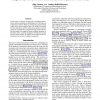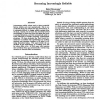1225 search results - page 162 / 245 » Design Principles for Intelligent Environments |
FLAIRS
2006
13 years 10 months ago
2006
In this paper, we describe an approach to modelling contextaware systems starting on the knowledge level. We make use of ideas from Activity Theory to structure the general contex...
WSC
2004
13 years 10 months ago
2004
The Hats Simulator is designed to be a lightweight proxy for many intelligence analysis problems, and thus a test environment for analysts' tools. It is a virtual world in wh...
AAAI
1998
13 years 10 months ago
1998
This paper presents a motivational system for an autonomous robot which is designed to regulate human-robot interaction. The mode of social interaction is that of a caretaker-infa...
FLAIRS
1998
13 years 10 months ago
1998
Our focus is on designing adaptable agents for highly dynamic environments. Wehave implementeda reinforcement learning architecture as the reactive componentof a twolayer control ...
AIPS
1994
13 years 10 months ago
1994
Autonomousmobile robots need to detect potential failures reliably and react appropriately. Dueto uncertainties about the robots and their environment,it is extremelydifficult to ...


